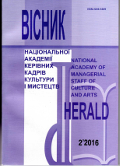NATIONAL ROOTS OF PIANO SYMBOLISM OF A.SKRYABIN PERFORMANCE STYLE
DOI:
https://doi.org/10.32461/2226-3209.2.2016.138508Keywords:
national style, symbolism, symbolism of piano play, performance style, salon artAbstract
The purpose of given work. Designation factors of piano performance style of Skrjabin, his symbolical sources, inveterated in impressionism-symbolism of C.Debussy and salon pianism of F.Chopin. Methodological basis of the work – intonational aspect of style comparative method, as this offered in the works of different authors [6; 4] and also in germenevtic positions of A.Losev [5] and others. Scientific novelty of the work is defining by originality of idea of symbolical principle of clavierism of Skrjabin, which reproduce in conditions of piano play sounding of “equivalent hands” of clavecin traditions. Conclusions. Performance style of Skrjabin is determined by dynamic and technique limitations of salon tradition, which resisted to theatrical orchestral style of academic pianism after Liszt. The offered systematization of the information about russian salon art. Also place of Skrjabin is chosen in symbolical salon of begin of XX cent.in accordance with traditions Russian salon piano art of Moscow and Petersburg.
Downloads
Published
Issue
Section
License
Authors who publish with this journal agree to the following terms:
1. Authors retain copyright and grant the journal right of first publication with the work simultaneously licensed under a Creative Commons Attribution License that allows others to share the work with an acknowledgement of the work's authorship and initial publication in this journal.
2. Authors are able to enter into separate, additional contractual arrangements for the non-exclusive distribution of the journal's published version of the work (e.g., post it to an institutional repository or publish it in a book), with an acknowledgement of its initial publication in this journal.
3. Authors are permitted and encouraged to post their work online (e.g., in institutional repositories or on their website) prior to and during the submission process, as it can lead to productive exchanges, as well as earlier and greater citation of published work (See The Effect of Open Access).


